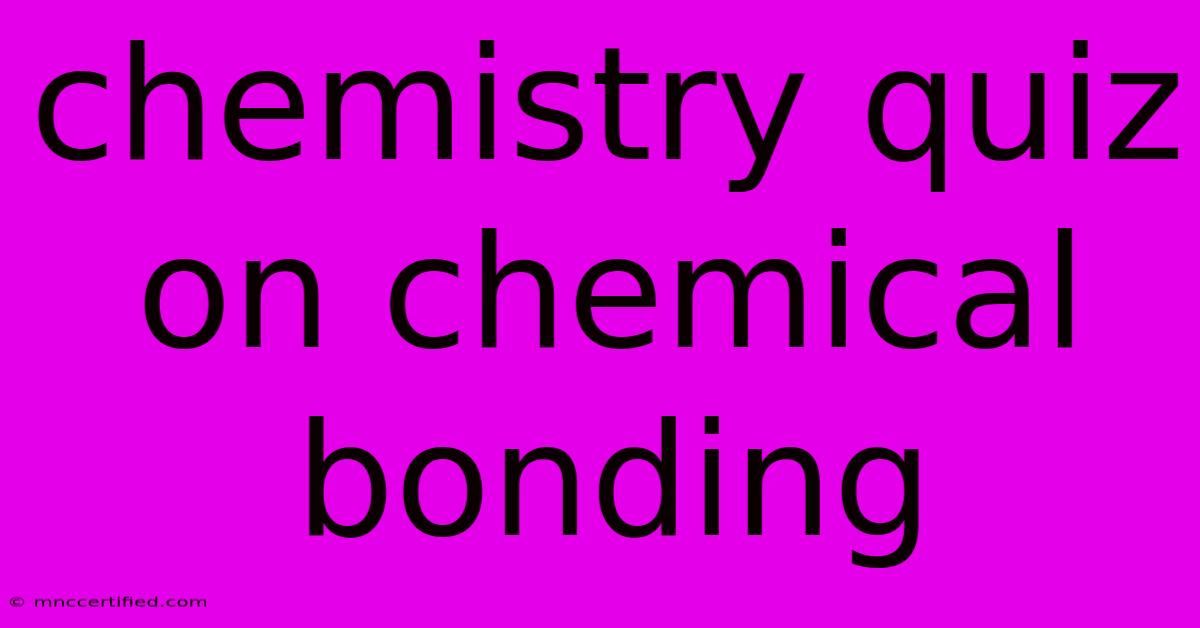Chemistry Quiz On Chemical Bonding

Table of Contents
Ace Your Chemistry Exam: Chemical Bonding Quiz
Chemistry can be a tough subject, but mastering chemical bonding is crucial for understanding the building blocks of the universe! This quiz will test your knowledge of ionic, covalent, and metallic bonding, along with key concepts like electronegativity and bond polarity.
Ready to test your skills? Let's get started!
Multiple Choice Questions
-
Which type of bond is formed by the sharing of electrons between atoms? a) Ionic bond b) Covalent bond c) Metallic bond d) Hydrogen bond
-
What is the difference between a polar covalent bond and a nonpolar covalent bond? a) Polar covalent bonds involve the sharing of electrons between atoms of the same element. b) Nonpolar covalent bonds involve the sharing of electrons between atoms with different electronegativity values. c) Polar covalent bonds involve the unequal sharing of electrons between atoms with different electronegativity values. d) Nonpolar covalent bonds involve the complete transfer of electrons from one atom to another.
-
Which of the following pairs of elements is most likely to form an ionic bond? a) Carbon and Oxygen b) Sodium and Chlorine c) Hydrogen and Oxygen d) Nitrogen and Oxygen
-
What is the name of the force of attraction between the positive and negative ions in an ionic compound? a) Covalent force b) Electrostatic force c) Metallic force d) Hydrogen bond
-
Which of the following is a characteristic of metallic bonding? a) High melting point b) Poor electrical conductivity c) Brittle nature d) Formation of discrete molecules
-
What is the difference between a single bond and a double bond? a) A single bond involves the sharing of one electron pair, while a double bond involves the sharing of two electron pairs. b) A single bond is stronger than a double bond. c) A double bond is formed between atoms of the same element, while a single bond is formed between atoms of different elements. d) A single bond is a polar bond, while a double bond is a nonpolar bond.
-
Which of the following molecules has a polar covalent bond? a) CO2 b) H2O c) CH4 d) Cl2
-
What is the electronegativity difference that generally defines an ionic bond? a) Less than 0.5 b) Between 0.5 and 1.7 c) Greater than 1.7 d) There is no specific electronegativity difference that defines an ionic bond.
-
What is the role of valence electrons in chemical bonding? a) Valence electrons are the electrons in the outermost shell of an atom, and they are involved in the formation of chemical bonds. b) Valence electrons are the electrons in the inner shells of an atom, and they are not involved in the formation of chemical bonds. c) Valence electrons are the electrons that determine the atomic radius of an atom. d) Valence electrons are the electrons that determine the ionization energy of an atom.
-
Which of the following is an example of a network covalent solid? a) Diamond b) Sodium chloride c) Copper d) Water
Answer Key
- b) Covalent bond
- c) Polar covalent bonds involve the unequal sharing of electrons between atoms with different electronegativity values.
- b) Sodium and Chlorine
- b) Electrostatic force
- a) High melting point
- a) A single bond involves the sharing of one electron pair, while a double bond involves the sharing of two electron pairs.
- b) H2O
- c) Greater than 1.7
- a) Valence electrons are the electrons in the outermost shell of an atom, and they are involved in the formation of chemical bonds.
- a) Diamond
How Did You Do?
Did you find the quiz challenging? If you struggled with some of the questions, don't worry! You can always review the concepts of chemical bonding in your textbook or online resources. Remember, understanding chemical bonding is fundamental to grasping many other chemistry topics.
Beyond the Quiz
- Practice, Practice, Practice: The more you practice, the better you'll understand the concepts. Try working through additional practice problems or reviewing past exams.
- Visualize the Concepts: Use diagrams and models to visualize how different types of bonds form. This can help you understand the concepts more deeply.
- Ask for Help: If you're still struggling, don't hesitate to ask your teacher or a tutor for help. They can provide personalized guidance and support.
By understanding the basics of chemical bonding, you'll unlock a deeper understanding of the world around you!

Thank you for visiting our website wich cover about Chemistry Quiz On Chemical Bonding. We hope the information provided has been useful to you. Feel free to contact us if you have any questions or need further assistance. See you next time and dont miss to bookmark.
Featured Posts
-
Xcel Energy Center Tate Mc Rae Concert August 13 2025
Nov 15, 2024
-
Latin Grammy Awards 2024 Red Carpet Arrivals
Nov 15, 2024
-
Solve Wordle 1245 Hints And Answer For Friday
Nov 15, 2024
-
Uefa Investigation Referee Cootes Video Review
Nov 15, 2024
-
Jalen Hurts Injury Report Eagles Qb Concussion
Nov 15, 2024